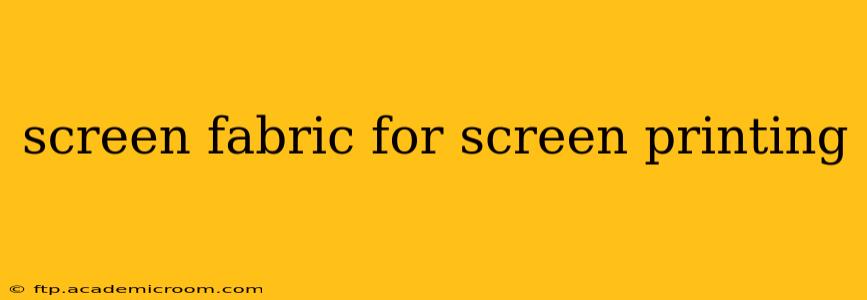Choosing the right screen fabric is crucial for successful screen printing. The fabric's mesh count, material, and overall quality directly impact the print's detail, durability, and longevity. This guide dives deep into the world of screen fabrics, helping you select the perfect material for your projects.
What is Screen Fabric?
Screen fabric, also known as screen mesh, is the foundation of a screen printing stencil. It's a woven fabric stretched taut over a frame, forming a mesh through which ink is pushed onto the printing surface. The choice of fabric significantly influences the final print's quality and the printing process itself. Different fabrics cater to various needs, from fine detail work to printing on thick materials.
What are the Different Types of Screen Fabric?
Several types of screen fabrics exist, each with its unique properties:
1. Polyester:
- Pros: Polyester is the most popular choice due to its strength, durability, and resistance to stretching. It's relatively inexpensive and suitable for a wide range of printing applications. It's also easy to clean and reuse.
- Cons: Can be less durable than nylon for extremely high-volume printing.
- Best for: General-purpose screen printing, t-shirts, posters, and most common applications.
2. Nylon:
- Pros: Nylon is extremely strong and durable, offering excellent longevity for high-volume printing. It's also more resistant to harsh chemicals.
- Cons: More expensive than polyester.
- Best for: High-volume production runs, industrial printing, and applications requiring extreme durability.
3. Stainless Steel:
- Pros: Offers unparalleled durability and resistance to chemicals and high temperatures, ideal for specialized printing processes.
- Cons: Significantly more expensive than polyester or nylon, and requires specialized equipment for handling.
- Best for: Industrial printing, plastisol inks, and applications requiring extreme durability and resistance to harsh chemicals.
How is Screen Fabric Mesh Count Measured?
Screen fabric mesh count refers to the number of threads per linear inch (TPI) in the fabric. A higher mesh count means finer threads and smaller openings in the mesh. This impacts the detail level achievable in the print:
- Low mesh count (e.g., 43-61 TPI): Ideal for printing large, bold designs, thick inks (plastisol), and coarser fabrics. Allows for a faster print process due to the larger openings.
- Medium mesh count (e.g., 86-110 TPI): Versatile option suitable for a broad range of printing applications. Balances print detail with print speed.
- High mesh count (e.g., 156 TPI and above): Perfect for printing fine details and intricate designs, often used with water-based inks and delicate fabrics. Requires more careful handling and slower print speed.
What Mesh Count Should I Use?
The best mesh count depends on your project's specifics:
- Fabric type: Thicker fabrics might require a lower mesh count, while thinner fabrics can handle a higher mesh count.
- Ink type: Plastisol inks generally require lower mesh counts than water-based inks.
- Design complexity: Intricate designs benefit from higher mesh counts for better detail.
What other factors should I consider?
Beyond mesh count and material, consider these factors:
- Thread thickness: Thicker threads provide greater durability but may reduce detail.
- Stretch resistance: Choose a fabric with good stretch resistance to prevent distortion during printing.
- Chemical resistance: Select a fabric resistant to the chemicals in your inks and cleaning solutions.
How do I care for my screen fabric?
Proper care extends the lifespan of your screen fabric:
- Clean thoroughly after each use: This prevents ink buildup and clogging.
- Store properly: Keep screens flat and away from direct sunlight to prevent damage.
- Handle carefully: Avoid excessive stretching or bending to maintain the fabric's integrity.
This comprehensive guide provides a solid foundation for selecting the appropriate screen fabric for your screen printing needs. Remember to consider the project requirements and choose the mesh count and material best suited for optimal results. Remember, experimentation is key to mastering the art of screen printing!
